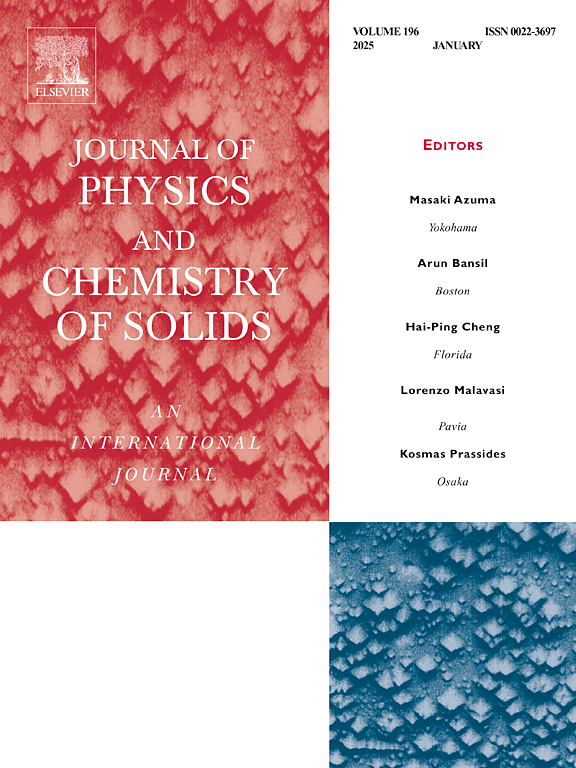Radiation-induced photoluminescence enhancement of zinc oxide and zinc oxide- polyvinyl alcohol nanocomposite: A green and controllable approach for tailor-made optoelectronics
IF 4.3
3区 材料科学
Q2 CHEMISTRY, MULTIDISCIPLINARY
引用次数: 0
Abstract
The structural and optical properties of gamma-ray-irradiated ZnO and ZnO-PVA nanocomposites, synthesized via a one-pot method, were investigated. The samples were analyzed before and after irradiation at doses up to 26 kGy using UV–Vis spectroscopy, photoluminescence spectroscopy, scanning electron microscopy, transmission electron microscopy, X-ray diffraction, Fourier transform infrared spectroscopy, and surface frequency generation spectroscopy. X-ray diffraction confirmed the hexagonal wurtzite structure of ZnO, while electron microscopy revealed the embedment of 40 nm ZnO nanoparticles into the PVA matrix. Shifts and decreased ratio of the CH2–CH2 FT-IR vibrations at 1420 cm−1 and combined CH2–CH2/CH2–O–CH2 stretching at 1143 cm−1 indicated not only polymer matrix dislocation resulting from incorporation of ZnO nanoparticles in the PVA matrix but also cross-linking of the polymer chains upon irradiation. Surface frequency generation spectroscopy further confirmed PVA adherence and bonding to ZnO surfaces. Photoluminescence studies revealed significant changes in the energy and intensity of the near-band-edge emission of irradiated ZnO nanoparticles attributed to the annealing of surface defects. UV–Vis spectroscopy of ZnO-PVA showed a dose-dependent absorption increase at 280 nm, suggesting polymer cross-linking. Additionally, the intensity of the blue photoluminescent peak located around 445 nm increased with irradiation dose indicating dose-dependent enhancement of ZnO-PVA bonding. These findings demonstrate that gamma-ray irradiation effectively modifies the optical and surface properties of ZnO-based materials, enhancing their performance for applications in flexible optoelectronics, light-emitting devices, and environmental sensors. The ability to precisely control material properties through irradiation offers new opportunities for developing advanced functional materials with improved performance and sustainability.
辐射诱导氧化锌和氧化锌-聚乙烯醇纳米复合材料的光致发光增强:一种绿色可控的定制光电子方法
研究了一锅法合成的γ射线辐照ZnO和ZnO- pva纳米复合材料的结构和光学性质。使用紫外可见光谱、光致发光光谱、扫描电子显微镜、透射电子显微镜、x射线衍射、傅里叶变换红外光谱和表面频率产生光谱分析了26 kGy辐照前后的样品。x射线衍射证实了ZnO的六方纤锌矿结构,而电子显微镜显示了40 nm的ZnO纳米颗粒嵌入PVA基质中。CH2-CH2在1420 cm−1处的FT-IR振动和CH2-CH2 / CH2-O-CH2在1143 cm−1处的联合拉伸的变化和比例的降低表明,不仅ZnO纳米颗粒掺入PVA基体导致聚合物基体位错,而且在辐照下聚合物链发生交联。表面频率产生光谱进一步证实了PVA与ZnO表面的粘附和键合。光致发光研究表明,由于表面缺陷的退火,ZnO纳米粒子辐照后的近带边发射能量和强度发生了显著变化。ZnO-PVA的紫外可见光谱在280 nm处显示出剂量依赖性的吸收增加,表明聚合物交联。此外,位于445 nm附近的蓝色光致发光峰的强度随着辐照剂量的增加而增加,表明ZnO-PVA键合的增强是剂量依赖性的。这些发现表明,伽马射线辐照有效地改变了zno基材料的光学和表面特性,增强了它们在柔性光电子、发光器件和环境传感器中的应用性能。通过辐照精确控制材料性能的能力为开发具有改进性能和可持续性的先进功能材料提供了新的机会。
本文章由计算机程序翻译,如有差异,请以英文原文为准。
求助全文
约1分钟内获得全文
求助全文
来源期刊
CiteScore
7.80
自引率
2.50%
发文量
605
审稿时长
40 days
期刊介绍:
The Journal of Physics and Chemistry of Solids is a well-established international medium for publication of archival research in condensed matter and materials sciences. Areas of interest broadly include experimental and theoretical research on electronic, magnetic, spectroscopic and structural properties as well as the statistical mechanics and thermodynamics of materials. The focus is on gaining physical and chemical insight into the properties and potential applications of condensed matter systems.
Within the broad scope of the journal, beyond regular contributions, the editors have identified submissions in the following areas of physics and chemistry of solids to be of special current interest to the journal:
Low-dimensional systems
Exotic states of quantum electron matter including topological phases
Energy conversion and storage
Interfaces, nanoparticles and catalysts.

 求助内容:
求助内容: 应助结果提醒方式:
应助结果提醒方式:


